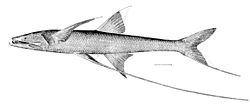Bathypterois grallator
Species of fish From Wikipedia, the free encyclopedia
The tripod fish or tripod spiderfish, Bathypterois grallator, is a deep-sea benthic fish in the family Ipnopidae found at lower latitudes. It is now an iconic deep-sea fish, being observed and photographed by submersibles, using elongate fin rays of the tail and pelvic fins to stand on the ooze. B. grallator is hermaphroditic.
This article needs additional citations for verification. (March 2025) |
| Tripodfish | |
|---|---|
 | |
| Illustration | |
 | |
| Bathypterois sp., which may be of this species, off Eleuthera | |
| Scientific classification | |
| Domain: | Eukaryota |
| Kingdom: | Animalia |
| Phylum: | Chordata |
| Class: | Actinopterygii |
| Order: | Aulopiformes |
| Family: | Ipnopidae |
| Genus: | Bathypterois |
| Species: | B. grallator |
| Binomial name | |
| Bathypterois grallator (Goode & T. H. Bean, 1886) | |
Characteristics
The tripodfish has long, bony rays that extend from the lower lobe of its tail fin and both pelvic fins. B. grallator is the largest member of its genus, commonly exceeding a standard length of 30 cm (12 in)[1] and reaching total lengths of up to 43.4 cm (17.1 in) long.[2] The tripodfish is often seen in its distinctive stance; standing on its three fin extensions (the namesake tripod) on the seabed, facing upstream with the antennae-like pectoral fin rays extended out, waiting for food.[3] Even though the fins are presumably quite stiff to be able to support its weight, observations of swimming fish shows that their fins seem flexible; it is suggested that fluids are pumped into these fins when the fish is 'standing' to make them more rigid.[4]
The tripodfish is closely related to the spider fish Bathypterois longifilis, which is similar in appearances and habits but is smaller and has much shorter fin extensions. They are often found standing very close to each other.[5]
Habitat
Bathypterois grallator has been found relatively widely in the Atlantic, Pacific, and Indian oceans from 40°N to 40°S. It is a wide-ranging eurybathic fish found from 878 to 4,720 m (2,881 to 15,486 ft) deep.[3]
Biology
Summarize
Perspective
Feeding
The tripodfish faces into the current, waiting for prey to drift by.[6] The fish uses tactile and mechanosensory cues to identify food; it apparently does not have special visual adaptations to help it find food in the low-light environment. When the fish is perched with its long rays on the ocean floor, it can get food without even seeing it. The tripodfish's mouth ends up at just the right height to catch shrimp, tiny fish, and small crustaceans swimming by. They seem to prefer to perch on the mud using much elongated fin rays in their tails and two pelvic fins to stand, facing upstream into the current to ambush with the pectoral fins turned forward so the outthrust projecting fins resemble multiple antennae. The fish senses objects in the water with its front fins. These fins act like hands. Once they feel prey and realize it is edible, the fins knock the food into the fish's mouth.[5][tone] Recorded prey includes copepods and other planktonic crustaceans, such as larvae.[2]
Reproduction
Each individual has male and female reproductive organs. If two tripodfish happen to meet, they mate. However, if a tripodfish does not find a partner, it makes both sperm and eggs to produce offspring by itself; thus, it is a true hermaphrodite.[7]
References
External links
Wikiwand - on
Seamless Wikipedia browsing. On steroids.

